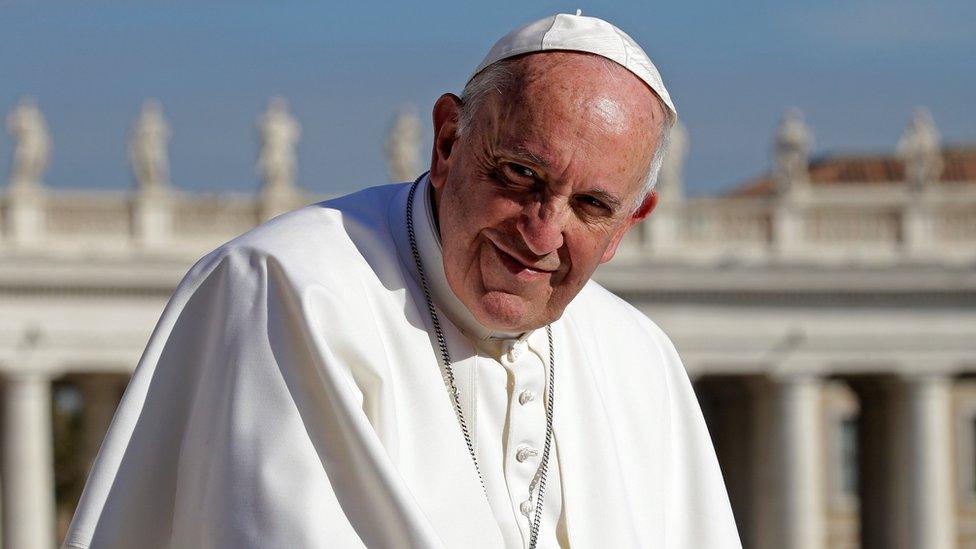Pope Francis greeted by ecstatic Philippines crowds
- Published
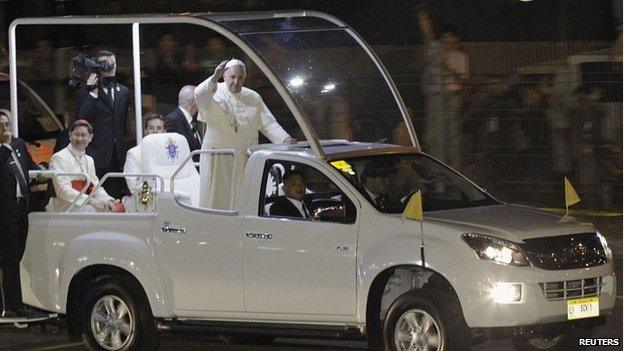
Pope Francis travelled in his white, open-sided Popemobile along the 11km (6.9 miles) route from the airport to the Apostolic Nunciature in Manila, where he is staying
The Pope has been greeted by hundreds of thousands of cheering people who waited several hours in steaming heat for his arrival in the Philippines.
They lined the streets of the capital Manila to glimpse his motorcade.
Millions more are expected to come out to see him over his five-day visit to the nation's 80 million Catholics.
The pontiff said that a priority of his visit would be to send a message to the poor who face "social, spiritual and existential" injustices.
"The central nut of the message will be the poor, the poor who want to go forward, the poor who suffered from Typhoon Haiyan and are continuing to suffer the consequences," he said while travelling to the Philippines from Sri Lanka.
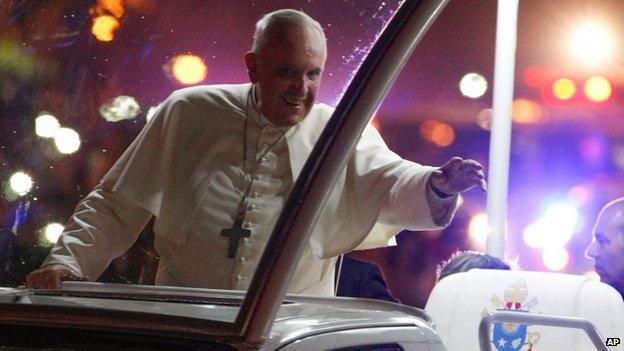
In a country with nearly a quarter of the population line below the poverty line, the Pope's call for the church to embrace the poor has struck a deep chord
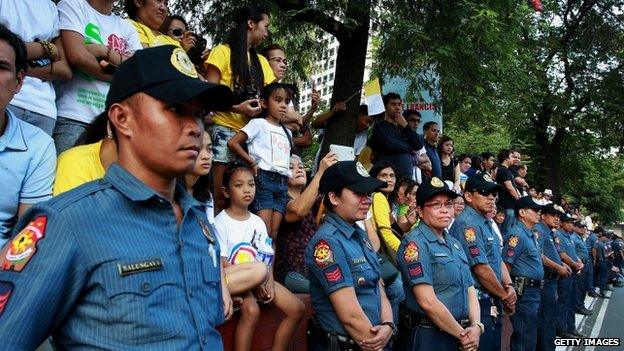
Hundreds of thousands of Filipinos waited hours in the steaming heat amid heavy security for a brief glimpse of the pontiff
Typhoon Haiyan killed or left missing more than 7,300 people, razing villages to the ground in the centre of the Philippines in 2013.
Leyte province was especially badly affected, and it is there where the Pope will seek to console survivors on Saturday.
He said that also prominent in his mind were some Filipino workers at the Vatican who had left their families for jobs overseas.
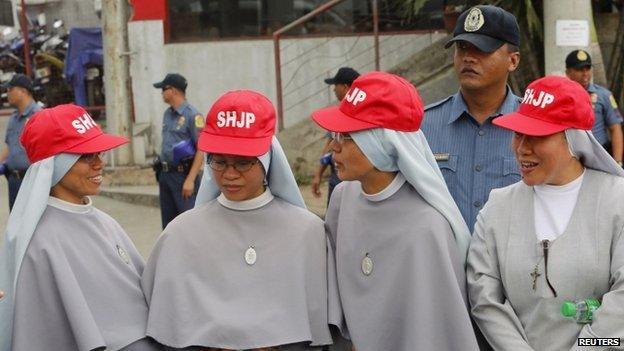
Members of the Sacred Heart Jesus Parish waited along the route
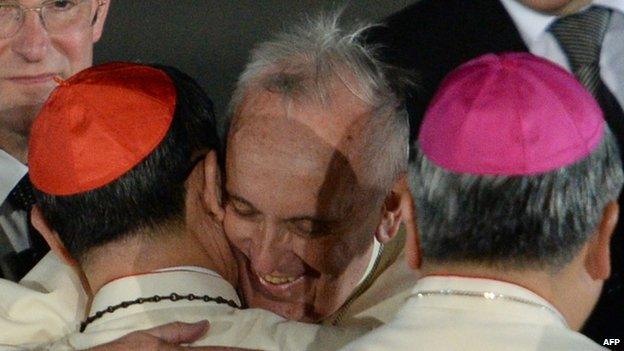
The Philippines' 80 million Catholics have always welcomed visiting popes warmly
The Philippines is one of the world's largest exporters of labour - it is estimated that about a tenth of the population has left the country in search of work - and reports of their abuse and exploitation are commonplace.
President Aquino has also spoken of his determination to eradicate poverty, although he has been at loggerheads with the local Roman Catholic Church over a 2012 reproductive health law that promotes artificial birth control.

At the scene: Rupert Wingfield-Hayes, BBC News, Manila
As Pope Francis passed me the huge grin on his face said it all. Millions of Philippine Catholics appear determined to try and see Pope Francis with their own eyes during this visit. That means huge crowds, and a potential security nightmare.
This country has "previous" when it comes to attacks on the Pope. In 1970 a man attacked Pope Paul VI with a knife at Manila airport. In 1995 Manila police discovered a plot by Muslim militants to assassinate Pope John Paul II.
On Thursday, as the Pope's plane landed, airspace around Manila was closed. Helicopter gunships circled overhead. About 25,000 police lined the route of his motorcade. But that did not prevent me from getting to within a few metres of his Popemobile without going through a single security check.

After leaving the airport, Pope Francis boarded an open-sided Popemobile to travel the 11km (6.9 mile) route to the Apostolic Nunciature in Manila, where he is staying.
The BBC's Rupert Wingfield-Hayes, who is accompanying the pontiff, says that huge cheers rose through the crowd as the white Popemobile swept past - with a clearly delighted Pope Francis grinning and waving from the back.
The highlight of his visit will be a huge open-air Mass in Manila on Sunday and a visit to Tacloban to meet survivors of a devastating typhoon in November 2013.
Security will be tight after failed attempts to kill two previous popes.
Tens of thousands of soldiers and police have been deployed.

While the pope is likely to be supportive of the efforts of Philippine President Benigno Aquino (back right) to tackle poverty, the pair may not see entirely eye to eye on issues such as reproductive rights and divorce
Pope Francis is the fourth pontiff to visit the Philippines - 80% of its 100 million people are Catholic.
A three-day public holiday has been declared in the capital to clear the traffic.
"Every step he makes, every car ride he takes, every moment he stays with us is precious for us," said Archbishop Socrates Villegas, president of Catholic Bishops' Conference of the Philippines. "Seeing him pass by is a grace."

Pope Francis's Philippines schedule
Thursday - arrives in Manila
Friday - meets President Benigno Aquino and celebrates Mass in Manila Cathedral
Saturday - heads to Tacloban, to celebrate Mass and have lunch with survivors of Typhoon Haiyan. Returns to Manila that evening.
Sunday - morning meeting with representatives of various religions and with young people, before celebrating Mass for up to six million people in Rizal Park

Officials say he will be sensitive about controversial issues such as inequality, reproductive rights and divorce by bridging the traditional teachings of the church with "new realities".
Crowds at his open-air Mass in the capital's Rizal Park on Sunday could exceed the five million who gathered for a Mass by Pope John Paul II in 1995, organisers say.
In a televised address on Monday, President Benigno Aquino urged all Filipinos to help protect the Pope.
In 1970, a Bolivian painter stabbed Pope Paul VI as he arrived in Manila, wounding him. In 1995, a week before Pope John Paul II's visit, police thwarted a plot by Muslim extremists to bomb his motorcade.
- Published2 October 2014
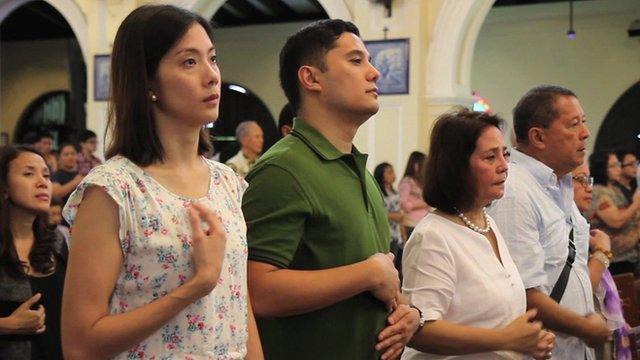
- Published25 May 2014
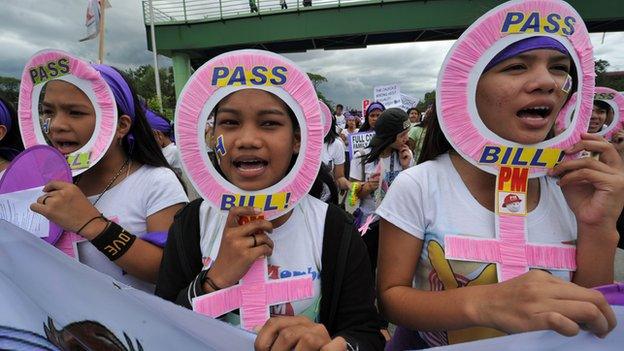
- Published14 January 2015
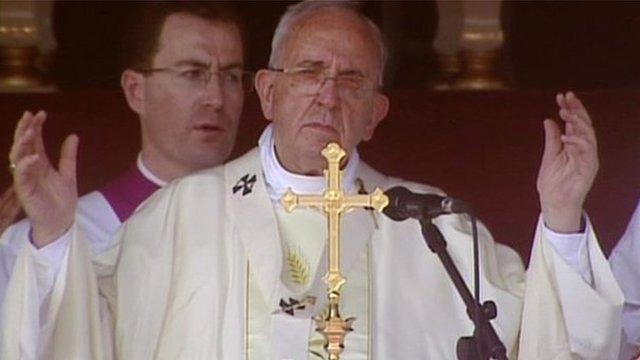
- Published13 January 2015
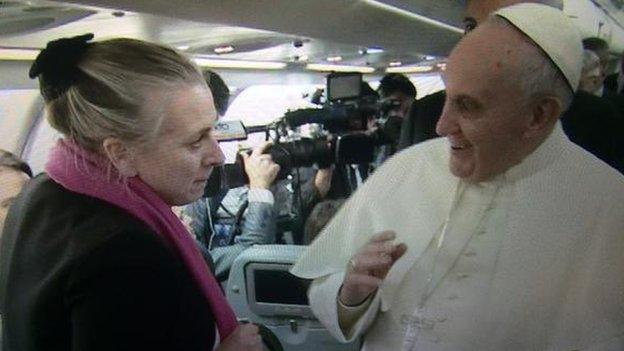
- Published7 January 2014
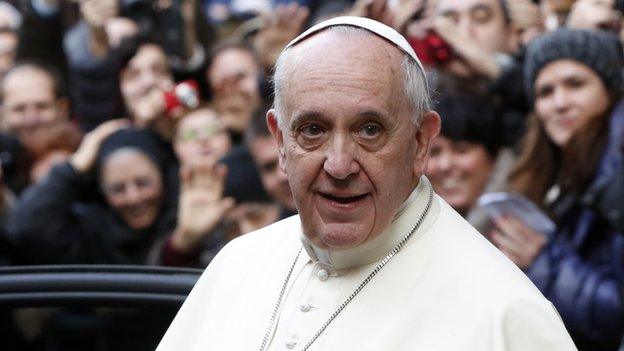
- Published28 October 2022
